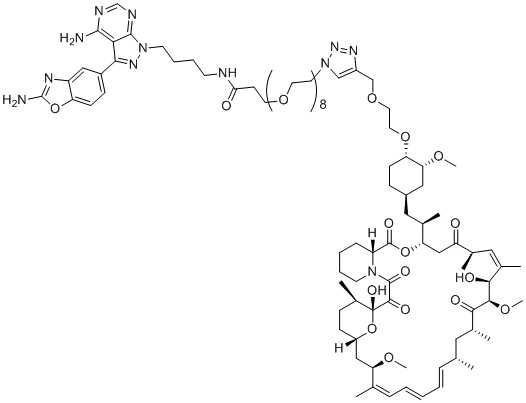| Cas No.: | 1887095-82-0 |
| Chemical Name: | 40-O-(2-((1-(32-(4-amino-3-(2-aminobenzo[d]oxazol-5-yl)-1H-pyrazolo[3,4-d]pyrimidin-1-yl)-27-oxo-3,6,9,12,15,18,21,24-octaoxa-28-azadotriacontyl)-1H-1,2,3-triazol-4-yl)methoxy)ethyl)-rapamycin |
| Synonyms: | RapaLink 1;RapaLink1 |
| SMILES: | C[C@@H]1CC[C@H]2C[C@H](C(=CC=C/C=C/[C@H](C[C@H](C(=O)[C@@H]([C@H](/C(=C/[C@H](C(=O)C[C@H](OC(=O)[C@H]3CCCCN3C(=O)C(=O)[C@@]1(O2)O)[C@H](C)C[C@H]4CC[C@@H]([C@@H](C4)OC)OCCOCC5=CN(N=N5)CCOCCOCCOCCOCCOCCOCCOCCOCCC(=O)NCCCCN6C7=C(C(=N6)C8=CC9=C(C=C8)OC(=N9)N) |
| Formula: | C91H138N12O24 |
| M.Wt: | 1784.17 |
| Purity: | >98% |
| Sotrage: | 2 years -20°C Powder, 2 weeks 4°C in DMSO, 6 months -80°C in DMSO |
| Description: | RapaLink-1, the third-generation bivalent mTOR inhibitor, combines Rapamycin with MLN0128 (a second-generation mTOR kinase inhibitor) by an inert chemical linker. RapaLink-1 shows better efficacy than Rapamycin or mTOR kinase inhibitors (TORKi), potently blocking cancer-derived, activating mutants of mTOR. RapaLink-1 can cross the blood-brain barrier. RapaLink-1 binding to FKBP12 results in targeted and durable inhibition of mTORC1. Anticancer activity[1][2]. |
| In Vivo: | RapaLink-1 (i.p.; every 5 days for 25 days, then once a week for 11 week) shows potent anti-tumor efficacy[1]. Animal Model: BALB/ Cnu/nu mice bearing U87MG intracranial xenografts[1] Dosage: 1.5 mg/kg Administration: I.p.; every 5 days for 25 days, then once a week for 11 week Result: Led to initial regression and subsequent stabilization of tumor size. |
| In Vitro: | RapaLink-1 (0-200 nM; 3 days) shows U87MG cells growth inhibition[1]. RapaLink-1 (0-12.5 nM; 48 hours) arrests U87MG cells at G0/G1[1]. RapaLink-1 selectively inhibits p-RPS6S235/236 and p-4EBP1T37/46 at doses as low as 1.56 nM[1]. RapaLink-1 exploits the unique juxtaposition of two drug-binding pockets to create a bivalent interaction. RapaLink-1 overcomes resistance to existing first- and second-generation inhibitors[3]. Cell Proliferation Assay[1] Cell Line: U87MG cells Concentration: 0-200 nM Incubation Time: 3 days Result: Showed growth inhibition. Cell Cycle Analysis[1] Cell Line: U87MG cells Concentration: 0-12.5 nM Incubation Time: 48 hours Result: Arrested cells at G0/G1. Western Blot Analysis[1] Cell Line: U87MG cells Concentration: 0.39-12.5 nM Incubation Time: 3 hours Result: Selectively inhibited p-RPS6S235/236 and p-4EBP1T37/46 at doses as low as 1.56 nM. The mTORC2 targets p-AKTS473, p-SGK1S78, and p-NDRG1T346, and the p-AKTS473 target p-GSK3βS9 was inhibited only at high doses. |
| References: | [1]. Fan Q, et al. A Kinase Inhibitor Targeted to mTORC1 Drives Regression in Glioblastoma. Cancer Cell. 2017 Mar 13;31(3):424-435. [2]. Kuroshima K, et al. Potential new therapy of Rapalink-1, a new generation mammalian target of rapamycin inhibitor, against sunitinib-resistant renal cell carcinoma. Cancer Sci. 2020 May;111(5):1607-1618. [3]. Rodrik-Outmezguine VS, et al. Overcoming mTOR resistance mutations with a new-generation mTOR inhibitor. Nature. 2016 Jun 9;534(7606):272-6. [4]. Mu F, et al. RapaLink-1 plays an antithrombotic role in antiphospholipid syndrome by improving autophagy both in vivo and vitro. Biochem Biophys Res Commun. 2020 Apr 30;525(2):384-391. |

 To enhance service speed and avoid tariff delays, we've opened a US warehouse. All US orders ship directly from our US facility.
To enhance service speed and avoid tariff delays, we've opened a US warehouse. All US orders ship directly from our US facility.




















